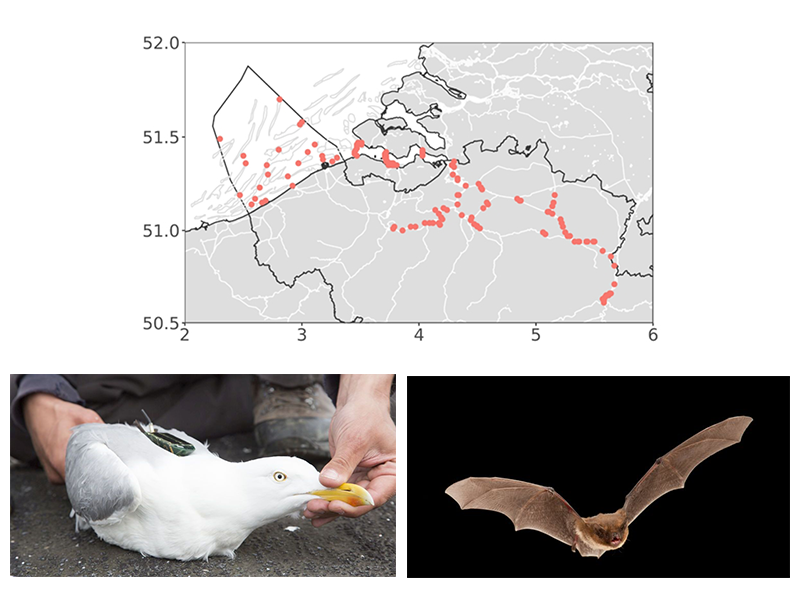
LifeWatch Belgium, as a part of the European LifeWatch infrastructure, can be considered as a virtual laboratory for biodiversity research. With the support of Flanders to LifeWatch, VLIZ has developed a Marine Observatory. It aims to collect scientific data with innovative technology in an automated manner, and to make these data freely available to all potential users. On the one hand, several innovative devices to map phytoplankton (Flow Cytometer) and zooplankton (Video Plankton Recorder) are used during monthly campaigns in the Belgian part of the North Sea. On the other hand, four passive networks register and detect the presence of larger organisms (birds, porpoises, bats and fish) with a minimal human effort.
Towards a European fish tracking network
In 2012 the development of an acoustic receiver network to follow fish was built by the Institute for Nature and Forest Research (INBO), Ghent University (UGent) and the Flanders Marine Insitute (VLIZ). Currently the network consists of 166 receivers, spread over the Belgian part of the North Sea, the Western Scheldt and various Belgian rivers and canals. Since the start of the project more than 800 fish were tagged already, mainly of highly endangered species like eels, cod and salmon.
Fish often migrate over large distances, between different habitats (like between fresh and salt water) and across national borders. Similar foreign networks can help in detecting the ‘Belgian’ tagged fish, and vice versa. That is why in the framework of the EU Horizon 2020 project AtlantOS, a large-scale European tracking network (ETN) was set up in 2017 in collaboration with LifeWatch, and which included the existing Belgian network. In order to keep track of the multitude of data resulting from this tracking network in a coordinated manner, VLIZ set up a data management platform. This system allows (meta) data to be added to the database, edited and consulted.
Passive acoustic network for cetaceans
The cetacean passive acoustic network is a network of acoustic receivers (set up by VLIZ and OD Nature), that detects the echolocation sound of porpoises and dolphins. Harbor porpoises, dolphins and whales produce clicking sounds with different frequencies to obtain an exact picture of their surroundings. Via C-PODs (passive acoustic devices) hung in the water, the clicking sounds of marine mammals are registered in the vicinity of the device.
Since the start up of the LifeWatch Observatory project, VLIZ has already installed eight C-PODs in the Belgian part of the North Sea, fixed to buoys, shipwrecks or artificial hard structures. The eight measuring devices lie on a line that runs from east to west and covers both near shore, the mid and offshore zones of the Belgian part of the North Sea. Regularly experts come together to discuss the results and progress of this sensor network.
Bat detection network along the coast and at sea
The bat detection network is a network of passive acoustic receivers (batcorders) that can perceive the echolocation sounds of bats. These flying mammals use echolocation to orient themselves and to search for prey. The call of bats vary between species and can thus provide information on species-specific behavior. The LifeWatch bat detecting network observes two peaks in bat numbers along the Belgian coast throughout the year, one in spring and one in autumn. These are caused by migrating bats.
During bat migration estuaries seem to be key areas. To collect information about the specific functions that estuaries offer to bats, batcorders were installed in the nature reserves of The Zwin (Knokke-Heist) and The Ijzermonding (Nieuwpoort). There is also a measuring point at the Marine Station Ostend and an offshore measuring point at a windturbine on the Thornton Bank. Species of bats that are frequently observed in our coastal areas are the common pipistrelle, the Nathusius’s pipistrelle, the common noctule, the serotine bat and the daubenton’s bat.
Bird tracking network
The GPS tracking network for birds is a sensor network that maps the habitat use and migration patterns of large birds such as the European herring gull, the lesser black-backed gull and the western marsh harrier. The INBO coordinates the research in collaboration with Ghent University (Research Group Terrestrial Ecology) and the University of Amsterdam. To date, 154 seagulls and 6 harriers have received a tracked and a name. Their locations (both historically and in real time) can be easily accessed via the online birdmap. VLIZ is responsible for the installation, maintenance and data flow of the sensor network.
LifeWatch Belgium: where does it stand in 2018?
The progress of these different networks, as well as the entire Belgian LifeWatch infrastructure (including the terrestrial component), was presented to the users and interested parties of the Belgian LifeWatch infrastructure on a two-day meeting at the end of January 2018. With 87 participants from various Belgian research institutions and universities, the event – which took place at VLIZ – was a great success. More information about the progress that LifeWatch Belgium has already made and the various user stories presented during the meeting can be found on the LifeWatch Belgium website.
Do you want to get started yourself? Be sure to check out the interactive map with all sensors of the observatory. Or just start exploring the data generated within the LifeWatch Belgium Marine Observatory.